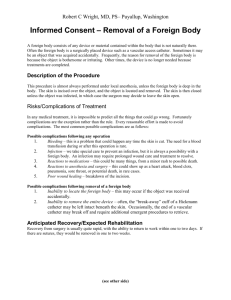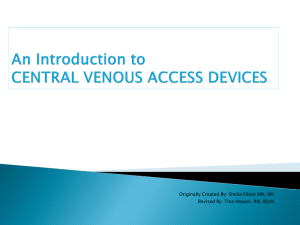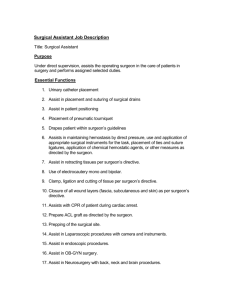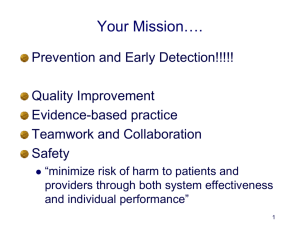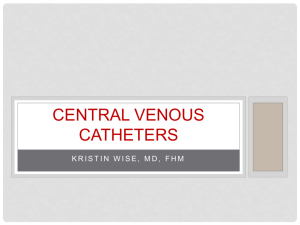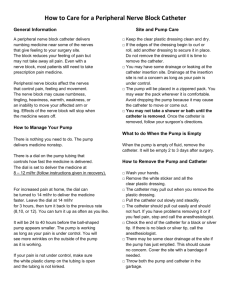Placement of Chronic Indwelling Venous
advertisement
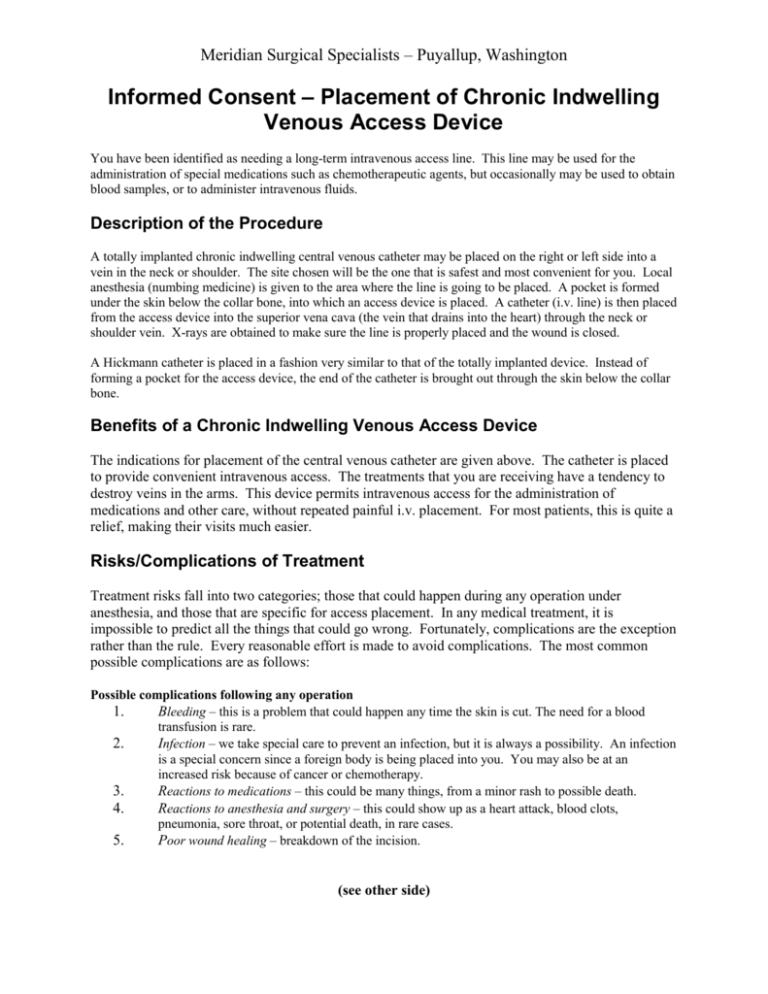
Meridian Surgical Specialists – Puyallup, Washington Informed Consent – Placement of Chronic Indwelling Venous Access Device You have been identified as needing a long-term intravenous access line. This line may be used for the administration of special medications such as chemotherapeutic agents, but occasionally may be used to obtain blood samples, or to administer intravenous fluids. Description of the Procedure A totally implanted chronic indwelling central venous catheter may be placed on the right or left side into a vein in the neck or shoulder. The site chosen will be the one that is safest and most convenient for you. Local anesthesia (numbing medicine) is given to the area where the line is going to be placed. A pocket is formed under the skin below the collar bone, into which an access device is placed. A catheter (i.v. line) is then placed from the access device into the superior vena cava (the vein that drains into the heart) through the neck or shoulder vein. X-rays are obtained to make sure the line is properly placed and the wound is closed. A Hickmann catheter is placed in a fashion very similar to that of the totally implanted device. Instead of forming a pocket for the access device, the end of the catheter is brought out through the skin below the collar bone. Benefits of a Chronic Indwelling Venous Access Device The indications for placement of the central venous catheter are given above. The catheter is placed to provide convenient intravenous access. The treatments that you are receiving have a tendency to destroy veins in the arms. This device permits intravenous access for the administration of medications and other care, without repeated painful i.v. placement. For most patients, this is quite a relief, making their visits much easier. Risks/Complications of Treatment Treatment risks fall into two categories; those that could happen during any operation under anesthesia, and those that are specific for access placement. In any medical treatment, it is impossible to predict all the things that could go wrong. Fortunately, complications are the exception rather than the rule. Every reasonable effort is made to avoid complications. The most common possible complications are as follows: Possible complications following any operation 1. Bleeding – this is a problem that could happen any time the skin is cut. The need for a blood transfusion is rare. 2. Infection – we take special care to prevent an infection, but it is always a possibility. An infection is a special concern since a foreign body is being placed into you. You may also be at an increased risk because of cancer or chemotherapy. 3. Reactions to medications – this could be many things, from a minor rash to possible death. 4. Reactions to anesthesia and surgery – this could show up as a heart attack, blood clots, pneumonia, sore throat, or potential death, in rare cases. 5. Poor wound healing – breakdown of the incision. (see other side) Possible complications of surgery to place a chronic indwelling venous access device 1. 2. 3. 4. 5. Pneumothorax – this is where your lung collapses. Should this occur, you will require additional chest x-rays and may require a chest tube and hospitalization. Injury to a major blood vessel – on rare occasions, the catheter may injure a large blood vessel, requiring additional surgery to have it repaired, or blood transfusions. These vessels can clot, causing major swelling. Inability to pass the catheter – catheter placement is not always technically possible. This cannot be predicted prior to surgery. Should this be the case, we will terminate the procedure and discuss other options with you. Infection of the access device at a later date – this could happen months or even years after the access device is placed. Your doctors and nurses will always take special precautions when they access this venous access device to avoid getting it infected. Port failure/occlusion – because the port is a mechanical device, it will always have the possibility of breaking or clotting off. Sometimes this is easily repaired, but often this will necessitate surgical replacement of the device. Anticipated Recovery/Expected Rehabilitation Recovery is variable, depending on the individual. Most people are able to resume unrestricted activity the day following surgery. For your safety, do not drive a motor vehicle or operate dangerous machines while on pain medication. The device can be used immediately in most cases. Consent for Treatment I understand my decision to have a venous access device placed in me. I have read and understand the above explanation of the procedure being proposed. My surgeon has answered my questions, and I choose to proceed with surgery. I understand that every operation may yield unexpected finding. I give the surgeon permission to act on his best judgment in deciding to remove or biopsy tissues that appear to be diseased, understanding that complications may arise from that action. I understand that while most people receiving a venous access device benefit from the operation, I may not. My condition may not improve, and it may worsen. No absolute guarantee can be made. HIPAA: Before and after surgery, unless otherwise requested in writing by you, visitors whom you invite to attend the surgery will be informed of the surgical finding, your surgical status, and anticipated recovery issues for effectiveness of communications. Because of the anesthetic, you may or may not remember these important details. PRINT NAME OF PATIENT ________________________________________________________________ SIGNATURE ______________________________________________ DATE _________________ WITNESS ________________________________________________ DATE _________________ SURGEON ________________________________________________ DATE _________________ RELATIONSHIP TO PATIENT IF SIGNATURE OF LEGAL GUARDIAN ________________________________ I waive the right to read this form, and do not want to be educated and informed of treatment risks; nonetheless I understand the need for this surgery and grant permission to the surgeon to proceed on my behalf. SIGNATURE __________________________________________________ DATE _________________ rev 6-30/kab
